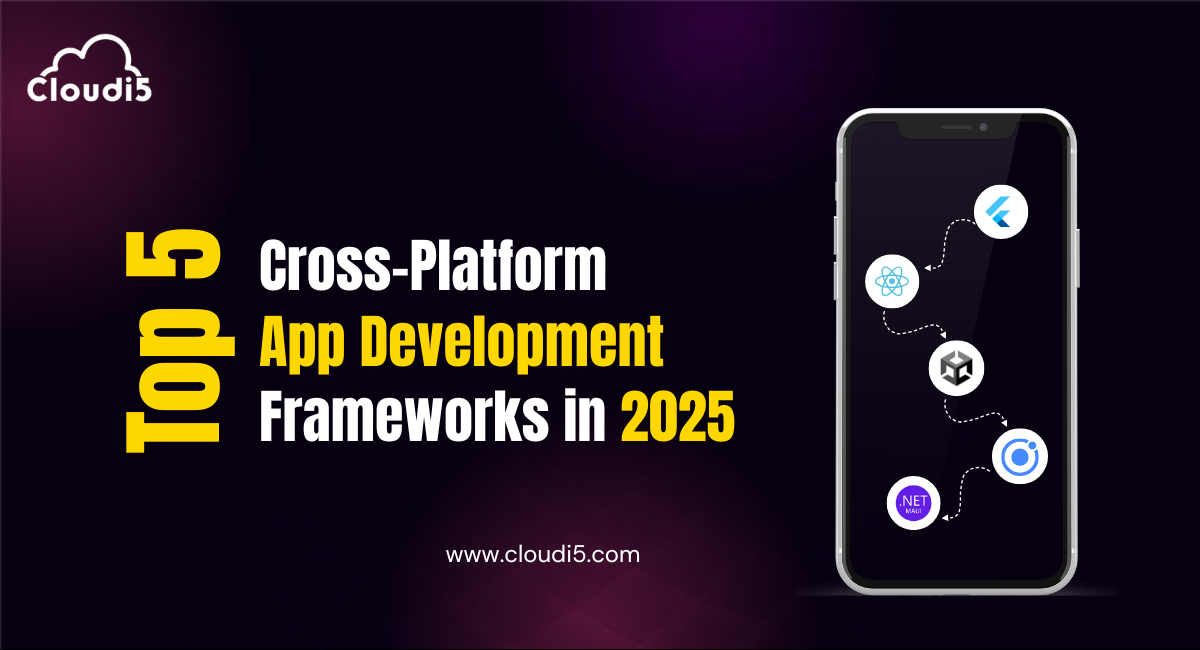
Top 5 Cross-Platform App Development Frameworks In 2025 (Ranked By Devs)
1. Introduction to Cross-Platform App Development in 2025
What is Cross-Platform Development?
Cross-platform app development means creating apps that work on both iOS and Android using a single codebase. Instead of writing separate code for each platform, developers use special frameworks to build apps that can run on multiple devices.
In 2025, popular frameworks like Flutter, React Native, and Kotlin Multiplatform make cross-platform development easier and more powerful. In this article, we’ll explore the Top Cross-Platform App Development Frameworks in 2025 Ranked by Devs to show you which tools are the best for building apps today.
Why Choose Cross-Platform for Mobile App Development in 2025?
Here are some reasons why cross-platform development is the preferred choice for mobile app developers in 2025:
- Cost-Effective: You only need one codebase for both iOS and Android, saving time and money compared to developing two separate apps.
- Faster Development: With tools like Flutter and React Native, you can develop apps quickly and launch them on both platforms at the same time.
- Consistent Experience: Cross-platform frameworks help create a similar look and feel for your app, no matter what device it's used on.
- Reach More Users: By building a cross-platform app, you can reach both iOS and Android users, expanding your app’s potential audience.
- Strong Developer Support: The Top Cross-Platform App Development Frameworks in 2025 Ranked by Devs are backed by large, active communities, providing support, tools, and resources to help developers.
2. How We Ranked the Best Cross-Platform Frameworks
Ranking Criteria: Performance, Developer Support, and Community Feedback
To determine the Top Cross-Platform App Development Frameworks in 2025 Ranked by Devs, we focused on key factors that developers care about most:
- Performance: How well does the framework perform in real-world apps? We looked at how quickly apps run, how smooth the user experience is, and how well each framework handles different features.
- Developer Support: A good framework should have solid documentation, active updates, and helpful resources. We ranked frameworks based on the support they offer to developers.
- Community Feedback: The opinion of the development community is crucial. We reviewed developer feedback from popular forums, blogs, and app development communities to see which frameworks developers prefer.
Data Sources: Developer Polls, GitHub Stars, and Industry Reviews
To ensure our rankings were based on reliable information, we gathered data from several sources:
- Developer Polls: We analyzed results from surveys and polls conducted with mobile developers, focusing on their experiences with different frameworks.
- GitHub Stars: The number of stars on a framework's GitHub repository is a good indicator of popularity and trust within the developer community. More stars usually mean a framework is widely used and appreciated.
- Industry Reviews: We also looked at expert reviews from top tech websites and app development blogs to gauge how each framework is viewed by professionals in the industry.
3. 1. Flutter: The Leading Cross-Platform Framework in 2025
Overview of Flutter
Flutter is an open-source UI framework developed by Google, designed for building natively compiled applications for mobile, web, and desktop from a single codebase. Since its launch, Flutter has rapidly become one of the Top Cross-Platform App Development Frameworks in 2025 Ranked by Devs due to its fast development cycles and high-performance capabilities.
Flutter uses the Dart programming language, which allows developers to create beautiful, responsive user interfaces and fast apps. It is known for its hot reload feature, enabling quick testing and iteration during development.
Key Benefits & Drawbacks of Using Flutter for App Development
Benefits:
- Single Codebase: With Flutter, developers can write one codebase for both iOS and Android, saving time and effort.
- High Performance: Since Flutter doesn’t rely on web views or JavaScript bridges, apps built with Flutter run natively, ensuring smoother performance.
- Great UI Design: Flutter’s widget-based architecture allows developers to create stunning and customizable UIs that work across platforms.
Drawbacks:
- Limited Libraries: While Flutter has grown rapidly, it still has fewer third-party libraries compared to other frameworks like React Native.
- Dart Language: While Dart is a powerful language, developers may need time to learn it since it's not as widely used as other languages like JavaScript.
Real-World Use Cases & Success Stories
Many well-known companies have adopted Flutter for their mobile apps, highlighting its capabilities in cross-platform app development:
- Google Ads: Google uses Flutter for its Google Ads app, showcasing Flutter’s reliability in real-world applications.
- Alibaba: This massive e-commerce platform built its app with Flutter, allowing it to maintain performance across multiple platforms with one codebase.
- BMW: BMW uses Flutter for their mobile app, providing a smooth and consistent user experience for both iOS and Android users.
These success stories show that Flutter is one of the leading cross-platform frameworks in 2025, widely trusted for building robust and high-performance apps.
Developer Reviews and Feedback on Flutter in 2025
According to developer reviews in 2025, Flutter is praised for its performance and ease of use. Developers often mention its fast development process and flexibility in creating custom UIs. However, some developers still mention the learning curve associated with Dart and the framework’s relatively smaller community compared to more established frameworks like React Native.
Overall, Flutter remains a top choice for developers looking to create high-performance, cross-platform apps with a beautiful UI.
4. 2. React Native: The Popular Choice for Cross-Platform Mobile Apps
What is React Native?
React Native is an open-source framework created by Facebook. It lets developers use JavaScript to build apps that work on both iOS and Android. This makes it one of the Top Cross-Platform App Development Frameworks in 2025 Ranked by Devs, thanks to its efficiency and wide use.
Pros & Cons of React Native for Mobile App Development
Pros:
- Single Codebase: Write one code that works on both iOS and Android, saving time.
- Fast Development: Features like hot reload let developers see changes instantly.
- Large Community: Many libraries and resources are available to help developers.
Cons:
- Performance: React Native may not perform as well as fully native apps in complex cases.
- Native Modules: Some features need custom native code, adding complexity.
Top Apps Built with React Native
Some big names use React Native:
- Facebook: The social media giant uses React Native in its app.
- Instagram: Instagram also switched parts of its app to React Native for better cross-platform support.
- Airbnb: Airbnb used React Native for some parts of its app, speeding up development.
Developer Insights and Feedback on React Native
In 2025, React Native remains popular for its speed and ease of use. While some developers report challenges with complex native features, the React Native community is active, making it easier to find solutions.
5. 3. Kotlin Multiplatform Mobile (KMM): Bridging the Gap for Android & iOS
Overview of Kotlin Multiplatform
Kotlin Multiplatform Mobile (KMM) lets developers share code between Android and iOS while keeping native performance. It’s becoming a go-to solution for cross-platform development in 2025 because of its flexibility.
Key Features and Advantages of KMM
- Native Performance: KMM allows apps to run natively on both platforms while sharing business logic.
- Code Sharing: A lot of code can be shared between platforms, cutting down development time.
- Kotlin: If you’re already using Kotlin for Android, KMM will feel familiar.
Best Use Cases for Kotlin Multiplatform
KMM is perfect for apps that need strong performance and shared logic, like:
- Apps with Complex Business Logic: KMM lets you keep platform-specific UIs but share business code.
- Real-Time Apps: Great for apps requiring fast data syncing and processing.
Developer Sentiment and Feedback on KMM in 2025
Developers are excited about Kotlin Multiplatform because it combines cross-platform development with native performance. Though it’s still new, it’s gaining popularity in 2025 for apps with complex requirements.
6. 4. Xamarin: A Powerful Cross-Platform Framework for Enterprise Apps
Xamarin Overview and Core Features
Xamarin, now owned by Microsoft, uses C# to create cross-platform apps for Android, iOS, and even Windows. It’s a top choice for enterprise applications in 2025 due to its integration with the .NET ecosystem.
Pros and Cons of Xamarin for Cross-Platform Development
Pros:
- Native APIs: Xamarin gives you access to native APIs for both iOS and Android.
- Code Sharing: You can share code across iOS, Android, and Windows apps.
- Enterprise-Ready: Xamarin is especially useful for building large-scale enterprise apps.
Cons:
- App Size: Xamarin apps can be larger than apps built with other frameworks.
- Learning Curve: If you’re not familiar with C# or .NET, there may be a learning curve.
Popular Enterprise Apps Built with Xamarin
- Alaska Airlines: Uses Xamarin for its mobile app.
- Bosch: Also uses Xamarin for enterprise solutions.
Developer Community Feedback on Xamarin
Xamarin is popular for enterprise apps, but developers new to C# may face challenges. Overall, it’s a reliable choice for building scalable and high-performance apps.
7. 5. Unity: The Best Cross-Platform Framework for Mobile Games
Why Unity is Ideal for Mobile Game Development
Unity is the best framework for mobile game development, offering powerful tools for creating 2D and 3D games. It's widely used in the gaming industry to create cross-platform games that run smoothly on iOS, Android, and other platforms.
Pros & Cons of Using Unity for Cross-Platform Apps
Pros:
- Great for Games: Unity excels at creating mobile games, especially those with complex graphics.
- Multi-Platform Support: You can develop games for multiple platforms from one codebase.
- Asset Store: Unity has a large marketplace for game assets, speeding up development.
Cons:
- Not for Non-Games: Unity is designed for games, so it's not ideal for simple apps.
- Complexity: Developing apps outside of gaming can be harder with Unity.
Successful Games Built with Unity
- Pokemon GO: Built using Unity, showcasing its power in AR and location-based games.
- Angry Birds 2: Another popular game developed with Unity.
Developer Opinion on Unity for Mobile Game Development in 2025
Unity is the top choice for mobile games in 2025, thanks to its flexibility and powerful game development tools. However, for non-game apps, developers might look at other frameworks like Flutter or React Native.
8. Honorable Mentions in Cross-Platform Development
.NET MAUI, Ionic, and NativeScript: Quick Overview
While Flutter, React Native, and Kotlin Multiplatform lead the way, frameworks like .NET MAUI, Ionic, and NativeScript are gaining popularity.
- .NET MAUI: The new framework from Microsoft for building cross-platform apps using .NET.
- Ionic: Best for hybrid apps and progressive web apps.
- NativeScript: Great for building native apps using JavaScript, TypeScript, or Angular.
Which Frameworks Are Gaining Traction in 2025?
In 2025, frameworks like .NET MAUI and Ionic are getting more attention for specific needs, like web app integration or Microsoft-based solutions.
9. Comparison: Flutter, React Native, Kotlin Multiplatform, Xamarin, and Unity
Side-by-Side Comparison of Features, Performance, and Usability
Here’s a quick breakdown of the Top Cross-Platform App Development Frameworks in 2025, comparing Flutter, React Native, Kotlin Multiplatform, Xamarin, and Unity based on key features and performance:
- Flutter
- Programming Language: Dart
- Best For: General mobile apps (iOS, Android, Web, Desktop)
- Performance: Native-like, fast
- Code Sharing: High across platforms
- UI Customization: Very high with custom widgets
- Development Speed: Fast (thanks to hot reload)
- Learning Curve: Easy for Dart developers
- Community & Support: Large and growing
- Ideal For: Fast, customizable mobile apps
- React Native
- Programming Language: JavaScript
- Best For: General mobile apps (iOS, Android)
- Performance: Good, but may lag with complex apps
- Code Sharing: High across platforms
- UI Customization: Limited, depends on native components
- Development Speed: Fast (thanks to hot reload)
- Learning Curve: Easy for JavaScript developers
- Community & Support: Large and well-established
- Ideal For: Quick, cross-platform mobile app development
- Kotlin Multiplatform
- Programming Language: Kotlin
- Best For: Apps needing shared business logic for Android and iOS
- Performance: Native performance with shared logic
- Code Sharing: High (business logic shared between Android and iOS)
- UI Customization: Medium, with native UI for each platform
- Development Speed: Moderate (requires platform-specific code)
- Learning Curve: Moderate (requires Kotlin expertise)
- Community & Support: Growing, but smaller compared to others
- Ideal For: Apps with complex business logic that need native features
- Xamarin
- Programming Language: C#
- Best For: Enterprise-level apps across Android, iOS, and Windows
- Performance: High, full native access
- Code Sharing: High across multiple platforms
- UI Customization: High, integrates with native UI
- Development Speed: Moderate (requires C# and .NET knowledge)
- Learning Curve: Steep for those unfamiliar with C#
- Community & Support: Strong, especially for enterprise apps
- Ideal For: Enterprise apps and cross-platform Windows solutions
- Unity
- Programming Language: C# (for game development)
- Best For: Mobile games (2D/3D)
- Performance: Excellent, especially for games
- Code Sharing: Medium, mainly for games
- UI Customization: Excellent for game graphics and UI
- Development Speed: Slow for non-game apps
- Learning Curve: Steep for non-gaming app developers
- Community & Support: Large, focused on game development
- Ideal For: Game development (especially 2D and 3D mobile games)
Cross-Platform Frameworks for Mobile Development: A Detailed Breakdown
- Flutter is great for high-performance mobile apps that need custom UI and fast development. It supports not only mobile apps but also web and desktop apps, making it a versatile choice in 2025.
- React Native is the go-to framework for developers familiar with JavaScript, offering good performance and fast development. It's widely used for building mobile apps for iOS and Android.
- Kotlin Multiplatform is ideal for apps that need native performance but also share business logic between Android and iOS. It’s gaining traction for its ability to integrate deeply with native features.
- Xamarin is perfect for building enterprise apps with native access across Android, iOS, and Windows. However, it requires developers to have expertise in C# and .NET.
- Unity is the best framework for mobile game development, offering powerful tools for creating 2D and 3D games. It’s not ideal for regular apps but shines in game creation.
Conclusion: Choosing the Right Cross-Platform Framework in 2025
In 2025, there are several great options for cross-platform mobile app development. Flutter and React Native are top choices for general mobile apps, with Flutter offering highly customizable UIs and React Native being ideal for JavaScript developers. Kotlin Multiplatform is perfect for apps that need native performance with shared code between Android and iOS, while Xamarin is great for enterprise apps, and Unity stands out in mobile game development. The right choice depends on your project’s needs and your team's skills. Additionally, Cloudi5 Technologies provides cloud-based tools and solutions that help developers efficiently build, deploy, and manage apps across platforms, integrating cloud services and data management for better performance and scalability.
Trusted By












Leave Comments